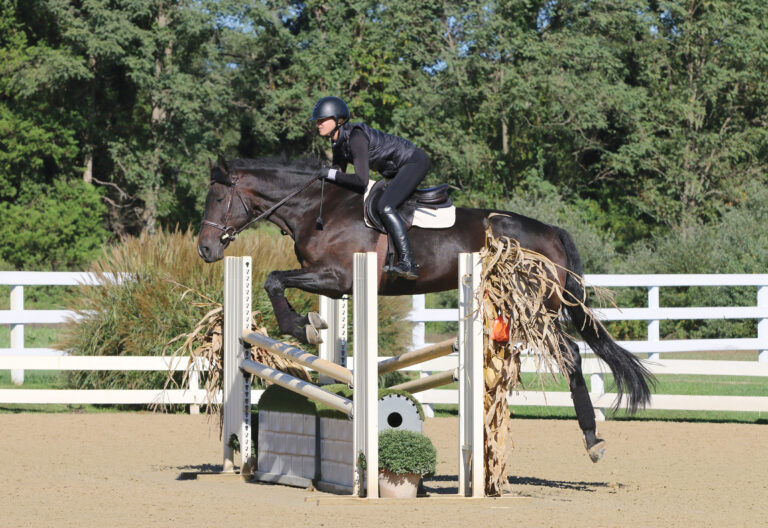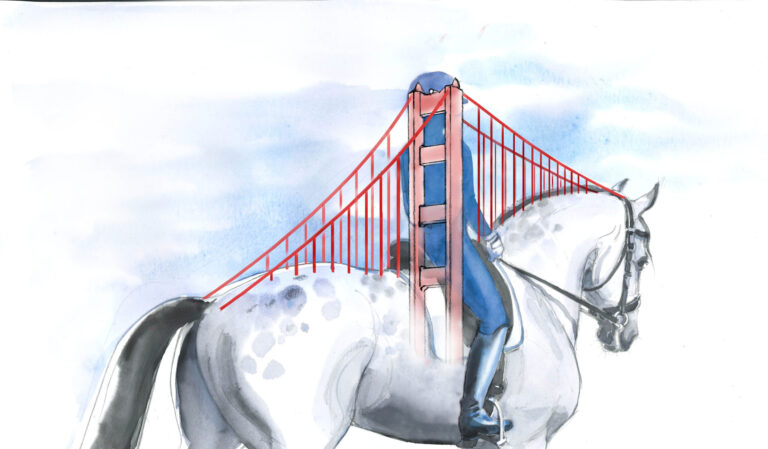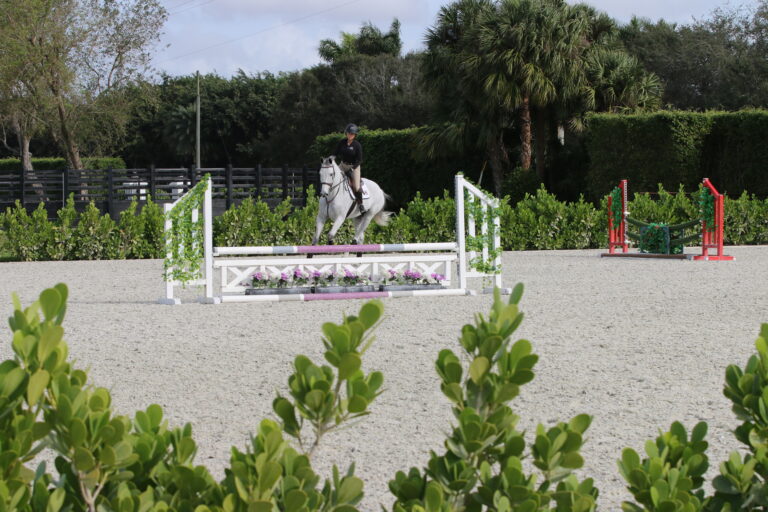Lillie Keenan and C Coast Z jumped an ivy-covered curved wall next to the farm entrance gate, cantered through a narrow opening to a brown stone wall set next to a barn, over a hay wagon, then to a blown-down tree. She galloped to the next field, past a pond and boat, across a creek, over a hedge lane and exited the farm over an iron gate.
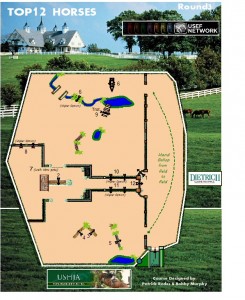 The course ?diagram for the top 12 handy round shows how the Sheila C. Johnson Arena was turned into a barnyard with two fields, a pond and farm entrance for riders to negotiate.
The course ?diagram for the top 12 handy round shows how the Sheila C. Johnson Arena was turned into a barnyard with two fields, a pond and farm entrance for riders to negotiate.While it might sound like she was out foxhunting across grand open landscape, Lillie was actually on her way to winning the 2011 USHJA International Hunter Derby Finals, presented by Dietrich Equine Insurance, at the Kentucky Horse Park in Lexington, August 20. Course designers Patrick Rodes and Bobby Murphy transformed the Sheila C. Johnson Arena into a barnyard during the final rounds, constructing a farm entrance, lane, barn, fields, hedges, gates?and even brought a fox and hounds (at least wood cutouts of them).
Under the bright arena lights and in front of the crowd of nearly 1,000 enthusiastic spectators, the 14-year-old from New York, New York, outrode seasoned professionals to take top honors. The original starting list of 58 top horse-and-rider combinations from across North America even included one of Lillie’s trainers from Heritage Farm, Patricia Griffith.
This was Lillie’s second year competing in the Finals on the 11-year-old gray Zangersheide gelding. The former grand-prix jumper was originally purchased as an equitation horse before he became a hunter. “I was definitely surprised. I didn’t think it was likely that a Junior could win,” said Lillie. “I knew I was going to have to give it my all. My horse was ready, but I needed to make it clear to him that I was ready, too, and that I needed him to shine at that moment.”
Coming into the top 12, Lillie said, “Scott Stewart was ahead of me, so I knew I needed to take some risks.” Scott had won the previous two rounds on another former grand-prix jumper, Carlos-Boy, a 16-year-old Holsteiner gelding. Unfortunately, when it came to the final round, the second of the day, Carlos-Boy became overly excited when he thought he was heading into a jumpoff, earning a score that dropped them to fifth in the final standings.
Eight judges in four teams of two scored each horse-and-rider pair. Riders ?received an extra point per judging team for each high fence option that was taken (up to 16 points). Each pair could also award up to 10 “handy” points for each rider based on the difficulty of the track, turns, and so on. Scores from the final handy round were added to the scores from the classic round, and the total decided the outcome.
Of her plan for riding the handy course, Lillie explained that most of the longer lines walked pretty open. “Going in, I thought I would just have to ride off my eye and trust that what I saw would end up being the right distance. As it turned out, the lines got a lot easier. It was a challenge to have them walk long and go in and suddenly [ride shorter], but I think that’s a place where you need to know you can trust your horse, trust your eye and just ride what you feel.”
Judge Julie Winkel said of Lillie’s ride, “She rode to win. The horse was consistent and beautiful, and you could see the teamwork. It looked like they had been together a long time.” Overall, the judges agreed that it was Lillie’s great hand gallop and collection to Fence 6 that locked in her win.
Here is a fence-by-fence breakdown of the course, as planned by the two designers, along with Lillie’s thoughts on how she rode each obstacle.
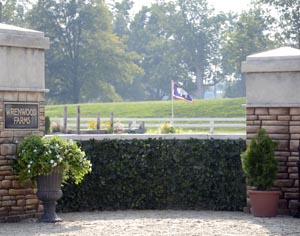 Fence 1: Curved Ivy Wall | ? Stacey Nedrow-Wigmore
Fence 1: Curved Ivy Wall | ? Stacey Nedrow-WigmoreFence 1: Curved Ivy Wall
Height: Just over 3-foot-6
Construction: Curved wall covered with ivy and flanked by two pillars. Wall had breakaway caps and a brush ground line.
Course Designer Notes: The horses cantered into the arena and rode directly to the first fence. “The curved wall zooms the horse in,” explained Bobby. “It’s still a little bit spooky because they have to go between those pillars, which are over ten feet tall and four feet wide.”
Lillie: Going into the ring, I was clear with my plan. On C Coast Z, I have a habit of not guiding him enough to the first fence, so I almost overcompensated and overprotected it. I think he was a little bit surprised, like, “Oh it’s dark, and there’s lights and lots of people are screaming and this is a funny-looking fence,” so I may have overreacted just a hair.
It didn’t look so much like a fence; it looked more like a decoration. It was a little shadowy and the light was hitting it a little funny, so I had to tell him, “This is the first fence, we have to get going.”
The first fence was easy, so it was fine. He landed left, and then I knew I had to get going if I really wanted it.
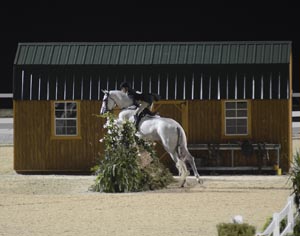 Fence 2: Kentucky Horse Park Foundation Wall | ? Stacey Nedrow-Wigmore
Fence 2: Kentucky Horse Park Foundation Wall | ? Stacey Nedrow-WigmoreFence 2: Kentucky Horse Park Foundation Wall
Height: 3-foot-9
Construction: A solid, brown stone wall, composed of three tiered boxes. It was set perpendicular to a prefabricated barn that had a saddle rack constructed from recycled arena fence boards, an old wheelbarrow with feed and other items that would be seen in a barnyard.
Course Designer Notes: “With it being busy in front of the barn, we didn’t want to make anything too complicated,” said Bobby. “It was fifteen feet wide, so horses could hit it at different angles to be handy from fence one to two. A lot of them jumped it at a pretty good angle, so they were almost jumping into the corner of the barn.”
Lillie: Riding toward the second fence, I had to guide him a little bit through the gap [between the farm lane and two angled gray walls used in the top 25 classic course]. I was afraid he was going to swap off if he looked too much to the right at the gray walls. I jumped fence 2 at quite a [left-to-right] slice, and I made sure I allowed him to land and finish his jump and then turn.
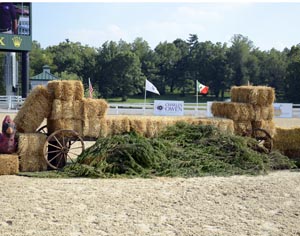 Fence 3: Dever Inc. Hay Wagon | ? Stacey Nedrow-Wigmore
Fence 3: Dever Inc. Hay Wagon | ? Stacey Nedrow-WigmoreFence 3: Dever, Inc. Hay Wagon
Height: Over 3-foot-9
Construction: Bobby got the idea for the fence driving down Newtown Pike in Lexington. “In one of the fields, they were baling hay and stacking it on the trailer. I took a picture of it and thought it would make a great jump.” He built a wood frame and stacked straw bales?provided by Dever, Inc.?across it.
Course Designer Notes: This fence ?encouraged the horses to jump well. “It was more about what they were going to do after they jumped the jump,” said Bobby. “Many times there’s an island you can go inside or around, but we thought it would just be better if things weren’t in the way as much. People can choose their own paths and not be directed to go one way or the other.”
Lillie: From watching the previous riders, I saw that the hay wagon was set up so you could cut in really tight around that USHJA oxer (Fence 4), so I turned real tight to it. I needed to make sure I held the left lead there, which I did. I landed and did a tight inside left turn to the oxer.
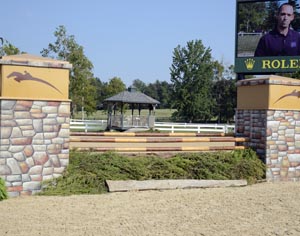 Fence 4: USHJA Pillars Oxer | ? Stacey Nedrow-Wigmore
Fence 4: USHJA Pillars Oxer | ? Stacey Nedrow-WigmoreFence 4: USHJA Pillars Oxer
Height: 3-foot-9
Construction:? “It was just your basic jump. It had rails with cedar underneath,” said Bobby.
Course Designer Notes: From Fence 3, riders made a right turn to the natural oxer. “It was an inviting jump; nothing too tricky,” said Patrick. The width of the rails [16 feet] allowed the riders to angle over it.”
Lillie: I jumped the oxer, waited for him to land and turned back tight to the left to Fence 5.
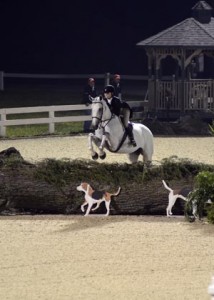 Fence 5: Log | ? Stacey Nedrow-Wigmore
Fence 5: Log | ? Stacey Nedrow-WigmoreFence 5: Log
Height: 3-foot-5
Construction: “It was an old log from the Horse Park that had blown down in one of the storms,” Patrick said. Fox and hound cutouts decorated the backside of it, and short pieces of intertwined brush were placed on top.
Course Designer Notes: Riders made a tight left turn around the hay wagon to the log. “When you put something that big in there, you worry whether the horses are going to spook at it,” said Patrick. “Since it’s such a massive jump, we didn’t want to build it too high, because we didn’t want to have an accident. But the horses ended up jumping it quite easy.”
Bobby added that because the hand gallop came up right after that fence, the designers didn’t want to put a jump there that would stir up any of the horses. “We wanted everybody to feel comfortable coming off that log and be able to show their hand gallops.”
Riders turned tighter than the designers expected from Fences 3 to 4 to 5, Bobby added. “It was a figure-eight loop back and forth. Usually we allow three strides for recovery and recollecting the horse. With the derbies now, they’re collecting their horses at one-and-a-half or two strides.”
Lillie: Going down to the log, I knew, there’s my gallop. I’m going to have to jump this one enough out of stride so that when I head through those standards, I’m going to have to run?go for broke!
Sitting up at the table before with my mom, she said, “Lil, I know it’s not likely that you’re going to win because you are a Junior, but you’ve got to go in there wanting it.” [My trainer] Andre [Dignelli] said the same thing. I knew if I wanted it, that gallop was the place to do it. I was just going to have to let him run. I’ve brought him out in the field once or twice, but I’ve never jumped a tree. I was more worried about landing and just turning it on.
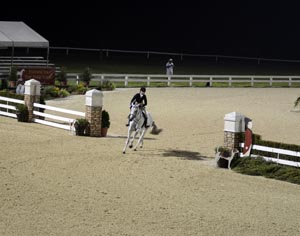 Hand Gallop to Next Field | ? Stacey Nedrow-Wigmore
Hand Gallop to Next Field | ? Stacey Nedrow-WigmoreHand Gallop to the Next Field
Course Designer Notes: After jumping the log, competitors rode through a gate and hand galloped down the long side in front of the stadium. This was a nice touch, particularly because it helped get the crowd involved: Spectators whistled and cheered as each rider galloped by.
Bobby explained: “The hand gallop has played a part since last year’s Derby Final. Some people had questioned the hand gallops of some of the horses, so we thought it was a good idea to put a hand gallop where it was center stage, in front of everybody.” He explained that the hardest part of the test for the riders was collecting their horses enough to make the inside turn past the boat (the low option Fence 6) and jump the high option wall.
Lillie: He galloped beautifully. The one thing I knew I could trust this horse to do is collect. You could be at a dead run like I was, and he will just drop back. I slipped inside the [boat] oxer. I wanted to make sure I didn’t lose my lead there either.
Fence 6 (low option): CN Chicago Hunter ?Derby Boat Oxer
Height: 3-foot-8
Course Designer Notes: No one took this option in the handy round. Bobby ?explained it was a jump they had made for the upcoming CN Chicago Hunter Derby, which took place September 11.
“I grew up at my grandfather’s farm, and we had the ?pond field.’ There was always the boat that was pulled up on the bank. It made for a neat fence. Some horses jumped it fine in the earlier rounds, and some didn’t. It was a little tough just because there weren’t necessarily any wings.” It also had narrower 10-foot rails.
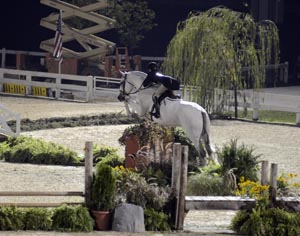 Fence 6 (high option): USHJA Wall | ? Stacey Nedrow-Wigmore
Fence 6 (high option): USHJA Wall | ? Stacey Nedrow-WigmoreFence 6 (high option): USHJA Wall
Height: 4-foot-4
Construction: It was a big jump, but inviting, with a curved ivy wall in front with brush on top.
Course Designer Notes: Everybody took this option. The boat prevented a straight track to the 16-foot-wide wall when competitors rode to the inside of it, which, Patrick said, caused a little bit of trouble. “Some horses spooked at that a little bit, just cantering by the boat. It also meant the riders hit the wall on an angle. The higher option did not really present any problems, though. We were a little concerned there because you had the creek and pond?there was a lot for the horses to look at.”
Lillie: I jumped it on a [left-to-right] slice, and it was perfectly fine.
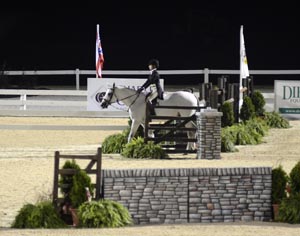 Fence 7: Walk Through the Gate | ? Stacey Nedrow-Wigmore
Fence 7: Walk Through the Gate | ? Stacey Nedrow-WigmoreFence 7: Walk Through the Gate
Course Designer Notes: Riders cantered up toward the barn, came back to the walk and rode through a narrow opening. Then they picked up the canter and turned right through another opening toward Fence 8, a natural oxer with rails. “It was a pretty tough option to walk through that gate and then pick up the canter and cut through the gate that’s next to the barn,” explained Patrick.
Lillie: I knew this horse would walk, like the collection, really quickly, so I wanted to get right up there. I did the transition a hair too early for this horse, but it was fine ?because I walked straight through the gate. I knew if I wanted to clear that next fence?I was doing the bigger option?I was going to have to get up to speed.
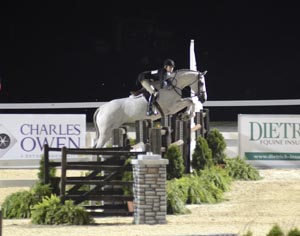 Fence 8: Natural Oxer with Rails (height option) | ? Stacey Nedrow-Wigmore
Fence 8: Natural Oxer with Rails (height option) | ? Stacey Nedrow-WigmoreFence 8: Natural Oxer with Rails (height option)
Height: High side (left), 4-foot-3; lower side (right), 3-foot-8
Construction: Natural rails
Course Designer Notes: Riders had to pick up a canter immediately after walking through the gate and roll back to a large natural oxer with rails. Patrick said the jump itself didn’t present any problems, but the horses had to be handy to go from a walk to canter, particularly if the rider chose the higher option. “What’s unique about it is that it had rails, so it tested the horse more,” explained Bobby. One thing to note was that by choosing the lower option, which at least one rider did, “you had to roll back tighter to it,” said Bobby.
Lillie: I picked up the right lead, started kicking, saw the distance and he gave it to me.
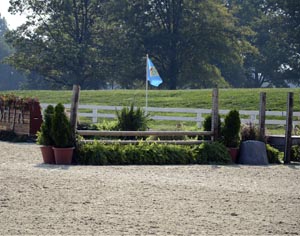 Fence 9: Trot Fence | ? Stacey Nedrow-Wigmore
Fence 9: Trot Fence | ? Stacey Nedrow-WigmoreFence 9: Trot Fence
Height: 2-foot-6
Construction: Small natural rails attached to the dock.
Course Designer Notes: Riders went back down by the pond again and trotted. “It was a fairly straightforward jump. We didn’t want to cause too much trouble ?being by the pond,” said Patrick.
Lillie: Because he originally was an ?equitation horse, he’s wonderful at trotting fences, so I’m not usually worried about it. I was afraid I might take it for granted a little bit, so going to it, I thought, “We’re near the end of the course and I need to make this perfect if I’m going to do this.” He trotted it just fine.
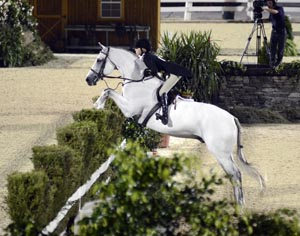 Fences 10 & 11: Hedge Lane In-and-Out (height option) | ? Stacey Nedrow-Wigmore
Fences 10 & 11: Hedge Lane In-and-Out (height option) | ? Stacey Nedrow-WigmoreFences 10 and 11: Hedge Lane In-and-Out (height option)
Height: High side (ends), 4-foot-6; low (center), 3-foot-9
Construction: Two sets of four brush jumps set in parallel lines with 27 feet ?between. The ends were the higher ?options and the center two sections were the lower options.
Course Designer Notes: From the trot jump, riders turned right and jumped over the lane in one stride. Most took the high options. “I was quite happy with the way the horses jumped it in the handy round,” said Patrick. “In the first round some horses had a little trouble jumping in there. It backed them off, and it did end up riding a little bit longer than what we thought it was going to.” Taking the inside track was the shorter route and made it handier.
Lillie: I saw most people do nine strides to the hedge I’d chosen to do [the high option]. I knew it was a place that I needed to show off and show that I trust my horse, so I galloped up in eight strides. When we walked it, it was eight or nine. So I landed and just started kicking. I saw it, and then I just pressed him through the one. He was perfect. He has all the scope in the world, so I wasn’t worried at all about galloping him down to the ?in-and-out.
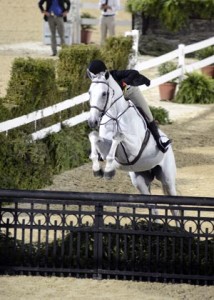 Fence 12: “Iron” Gate Oxer | ? Stacey Nedrow-Wigmore
Fence 12: “Iron” Gate Oxer | ? Stacey Nedrow-WigmoreFence 12: “Iron” Gate Oxer
Height: 3-foot-9 with 4-foot spread
Construction: A ramped black oxer, made to look like an iron gate.
Course Designer Notes: Riders made a quick right rollback and galloped down the lane that was created inside the in-and-out they’d just jumped and exited the farm.
“It ended up making a nice finale to the class,” explained Patrick. Bobby added, “It was neat because, even though the course didn’t say ?hand gallop’ on it, it was ?intended to be a hand gallop. You’re coming down the lane, and it’s your final fence. It was a long time between the combination and rolling back to that last fence. It really tested the rider’s eye.”
It was the perfect ending to a nearly perfect course, both designers agreed. Bobby said, “I was out on course during the top 12 and I was standing with our field judge, Roy Coyle, as the riders came around the corner to the lane. It was so touching to see the emotions of the riders. Like Lillie, she knew she had a perfect course leading up to that. And she starts going down the lane and people are starting to celebrate. Between that and the hand gallop, it was a good feeling.”
Lillie: Turning to the last fence, I know on the course diagram it didn’t say it was a hand gallop, but I knew if I wanted to win it, I needed to start running. I saw a long distance to it and, for a second, I questioned myself and I thought, I’m going to do one more. When I came out Andre and Patricia told me they were worried ?because I was risking it all right there.
I heard the crowd start screaming when I started picking up the pace, and I knew this was it. I was going to have to make it work. He really took care of me. Any horse could have chipped there, but he knew not to. To hear everyone screaming when I landed was unreal!
This article originally appeared in the November 2011 issue of Practical Horseman magazine.





